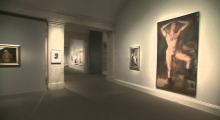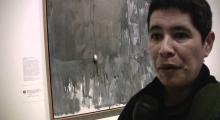Medium
Period & Style
Location
People
Discussion by Jonathan Katz, co-curator of “Hide/Seek” and Chair of the Visual Studies Doctoral Program at SUNY-Buffalo.
Paul Cadmus’s depiction of a world divided between light and darkness, virtue and vice, homosexuality and heterosexuality, summed up not only what was at stake, but also what was of value at the end of World War II. To the right are the forces of evil, shown both allegorically and historically, as in the figure of Hitler. But to the left are scenes of largely homoerotic love and creativity, which herald a return to Eden. In the new era that now dawned, the classical arts-painting, literature, architecture, music-would lead civilization forward again after its self-destruction. Cadmus took his title and theme for this work from a 1938 essay by the English writer E. M. Forster, who says, "Where do I start? With personal relationships." Forster and Cadmus were friends, and the writer gestures toward the seated Cadmus and Jared French (with Margaret Tooker behind them.) Forster was writing in resistance to the war to come, while Cadmus depicted the world that he hoped would be born.
"Hide/Seek: Difference and Desire in American Portraiture" was on view at the National Portrait Gallery, Smithsonian Institution, from October 30, 2010 through February 13, 2011.
For more on the exhibit, visit the exhibit website at: http://npg.si.edu/exhibit/hideseek .
Paul Cadmus (1904-1999) Egg tempera on pressed wood panel, 1947-48 McNay Art Museum, San Antonio, Texas; gift of Robert L. B. Tobin
Comments
Brought to you by NPG






